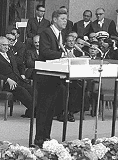The Cold War | Civics: Links to History
Updated July 22, 2020 |
Infoplease Staff


 |
Links to History: The Cold War
- 1945
- 1945 Soviet army marches into Berlin; the German capital city falls. World War II ends. Soviet Union, United States, Great Britain, and France divide Berlin and Germany into four zones of occupation, a decision made during the Yalta conference.
- 1946 British Prime Minister Winston Churchill's “Iron Curtain” speech marks beginning of the Cold War.
- 1947 U.S. President Harry Truman requests funds to support Greek and Turkish efforts to fight communism. It marks the beginning of the Truman doctrine.
- 1948 The Berlin airlift supplies West Berlin with basic necessities after the Soviet Union blocks off the city in an effort to force the West to give it up.
- 1949 The North Atlantic Treaty Organization (NATO) is formed by the United States and many western European countries to defend Europe against Soviet aggression.
- 1949 Communist forces under Mao Zedong take over mainland China. The United States continues to support the government of Nationalist China, led by Chiang Kai-shek, which is forced to retreat to the island of Taiwan.
- 1950
- 1950 U.S. Senator Joseph McCarthy begins his communist witch hunt in the United States.
- 1950 The Korean War begins, the first armed conflict in the Cold War, the global struggle between communism and democracy.
 source: Corbis/Bettmann
source: Corbis/Bettmann- 1953 More than 300,000 East Germans flee to West Berlin and then to West Germany.
- 1954 The Central Intelligence Agency (CIA) assists in the overthrow of Guatemala's communist-influenced government.
- 1954 Southeast Asia Treaty Organization (SEATO) is formed to thwart the spread of communism in Southeast Asia.
- 1954 The Vietnam War begins shortly after Vietnam is divided into communist North Vietnam and non-communist South Vietnam. The United States' involvement spans 1961-73, making it the country's longest war.
- 1955
- 1955 The Warsaw Pact is formed by the Soviet Union and communist countries in eastern Europe as a military defense organization to counter NATO.
- 1959 Cuba becomes communist under Fidel Castro.
- 1960
- 1961 Soviet-controlled East Germany divides Berlin with the Berlin Wall.
- 1961 The Alliance for Progress is formed, a U.S.-sponsored program to counter communism in Latin America.
- 1961 The U.S. orchestrates the ill-fated Bay of Pigs invasion, an unsuccessful attempt by Cuban exiles to overthrow Fidel Castro's communist regime in Cuba.
- 1962 The Cuban Missile crisis sparks a major confrontation between the United States and the Soviet Union when the U.S. discovers the existence of Soviet missile installations in Cuba.
 source: Corbis/Bettmann
source: Corbis/Bettmann- 1963 U.S. President John F. Kennedy tells a crowd of Germans in Berlin that the Wall proves the failure of the Soviet system.
- 1965
- 1970
- 1972 U.S. President Richard Nixon becomes the first U.S. leader to visit communist China, leading to a thaw in Cold War relations.
- 1972 Strategic Arms Limitation Treaty I (SALT I) is signed by the Soviet Union and the United States, limiting the proliferation of weapons, including nuclear missiles.
- 1973 The Central Intelligence Agency (CIA) secetly helps overthrow Chile's socialist government under Salvador Allende.
- 1975
- 1979 The Soviet Union invades Afghanistan, beginning a decade-long war that ends with their withdrawal in 1988.
- 1980
- 1985
- 1985 Mikhail Gorbachev becomes Soviet leader; he begins to ease away from old communist policies.
- 1987 U.S. President Ronald Reagan and Soviet leader Mikhail Gorbachev sign INF treaty, which removes medium and short-range nuclear missiles.
 source: Peter Turnley, Corbis/Bettmann
source: Peter Turnley, Corbis/Bettmann- 1989 The Berlin Wall falls.
- 1990
- 1990 East and West Germany are reunited.
- 1991 The Strategic Arms Reduction Talk (START) is signed by U.S. President George H. W. Bush and Soviet leader Mikhail Gorbachev, Gorbachev calling for additional disarmament of U.S. and Soviet nuclear weapons.
- 1991 The Soviet Union breaks up into independent republics; the Cold War ends.
See also:








